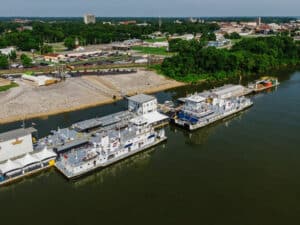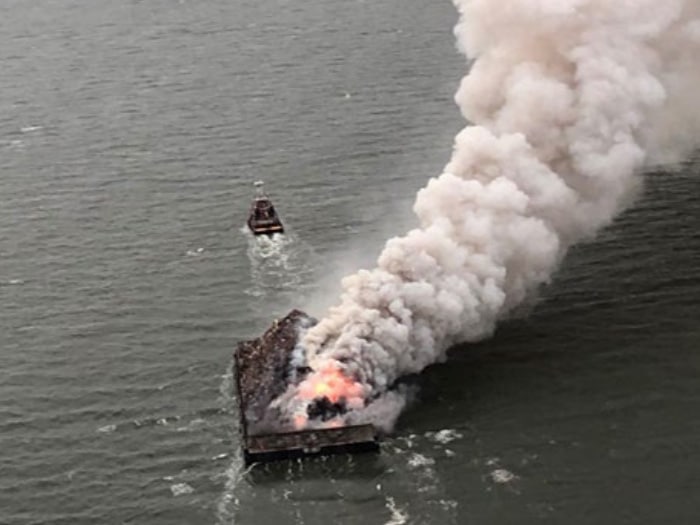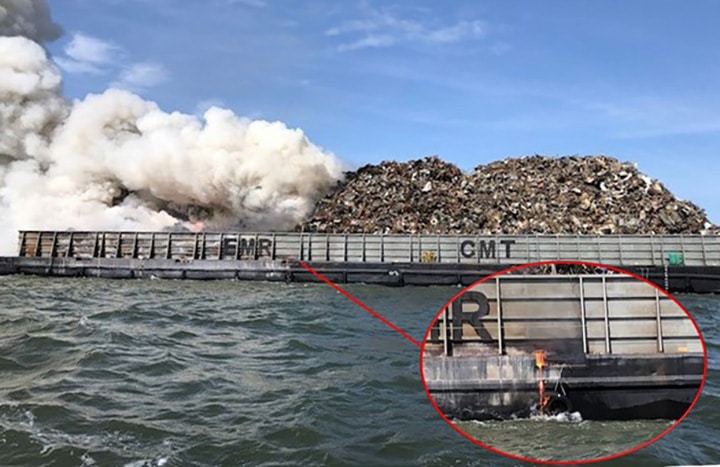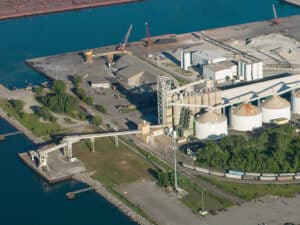
Scrap metal barge fire brings warning on lithium-ion battery dangers
Written by Nick Blenkey
Barge fire burned for 26 hours [USCG photograph]
The National Transportation Safety Board said Thursday that lithium-ion batteries and other possible ignition sources could pose a fire safety issue in the transportation of scrap materials as cargo. The warning comes after the agency released its report on a May 23, 2022, incident in which a fire discovered aboard a scrap metal barge burned for 26 hours before it was extinguished by fireboats.
The barge fire involved the loaded 300-foot-long scrap metal barge CMT Y Not 6 when it was under tow by the Coeymans Marine Towing (CMT) towing vessel Daisy Mae, northbound in the Delaware Bay, under bareboat charter to an affiliated entity of Eastern Metal Recycling USA (EMR) of Camden, N.J.
At about 00.30 a.m., local time, after exiting the Daisy Mae’s engine room, the AB on watch looked aft at the barge and saw smoke and a glow emanating from the pile of scrap metal in the darkness.
That was the beginning of a harrowing drama that is recounted in detail in the full report, which like all NTSB reports is well worth reading in full to get a picture of what actually went on for the vessel crew involved.
In its analysis of the incident, NTSB notes that, “the crew quickly notified their company management of the fire. They shortened the tow wire to the barge for better control and moved the vessel away from any marine traffic. Considering the Daisy Mae’s distance from the barge and need to keep the tow line attached to control the barge, the Daisy Mae crew took the appropriate steps to prevent and fight the fire.”

At 01.10 a.m, a Coast Guard small boat and two local municipality fire boats arrived on scene and began fighting the fire. At this point, the fire on the barge had grown to an “inferno,” as described by the mate. The barge was towed into shallower water, and more tow wire was let out so that its weight lay on the bottom to hold the barge on location. Aided by four additional fire boats from neighboring municipalities, firefighting efforts continued for the next 24 hours before the fire was finally extinguished. No injuries or pollution were reported. Damage to the barge was estimated at $7 million. There was no damage to the towing vessel.
POSTCASUALTY INVESTIGATION
The postcasualty inspection of CMT Y Not 6 revealed structural damage consistent with a high-temperature fire concentrated in the aft section of the barge, says the NTSB. The scrap metal cargo in that area also exhibited signs of a high-temperature fire. Much of the scrap metal had melted from the heat and then solidified when the fire was extinguished, creating large metal pieces. The magnitude of the fire and the destruction of the cargo in the area where the fire was first identified prevented investigators from determining a conclusive origin of the fire. However, investigators found flammable nonmetallic materials, such as plastic, rubber, insulation, and electrical components, within the nondamaged cargo. It is likely that these materials were present throughout the cargo and, once exposed to an ignition source, caught fire and then fueled and sustained the fire.
Investigators considered several potential ignition sources for the barge and noted that “the scrap metal cargo included end-of-life vehicles and appliances. Improperly prepared vehicles and appliances within the scrap metal that could have contained small amounts of flammable liquids or other prohibited materials also could have been an ignition source.
“Another potential source of ignition was damaged lithium-ion batteries, although suppliers screened the cargo for prohibited materials such as lithium-ion batteries before it was loaded on board the barge. EMR’s vice president of operations acknowledged the fire dangers associated with lithium-ion batteries, their increasingly prolific use in a wide range of products, and the difficulty in identifying them during the screening process.”
Due to the severity of the fire on the barge, which destroyed materials in its area of origin, investigators were not able to determine its exact cause.
PROBABLE CAUSE
The National Transportation Safety Board determines that the probable cause of the fire aboard the deck barge CMT Y Not 6 was the ignition of a combustible material by an undetermined source, such as sparking from shifting metallic cargo, self-heating of metallic or nonmetallic cargo, improperly prepared vehicles and appliances, or damaged lithium-ion batteries.
LESSONS LEARNED
Although scrap metal cargo is typically nonhazardous and poses a low fire risk, says NTSB, there have been recent vessel fires involving such cargo. Even with supplier acceptance agreements and quality assurance personnel visually inspecting scrap metal, metallic and nonmetallic hazardous materials often are present within shoreside scrap metal piles and could be loaded onto vessels. These often-flammable materials elevate the fire risk and can lead to intense fires. Qualified cargo-surveying personnel can assist the vessel’s captain before and during loading operations to limit the presence of hazardous, combustible material in scrap metal. Thermal imagery is an effective tool that could be used to identify hot spots in scrap metal cargo at shoreside facilities. Once scrap metal is loaded onto a barge, it is difficult for a towing vessel crew to visually inspect the cargo while underway.
- Download the full NTSB report HERE


![Tom Frazier aground and listing to starboard on Feb. 11, 2024. [Photo: U.S. Coast Guard]](https://www.marinelog.com/wp-content/uploads/2025/06/Towboataground-300x225.jpg)

